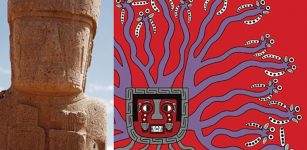1,000-Year-Old British Buckle Discovered In Danish Viking Grave
MessageToEagle.com – About 1,000-year-old small gilt bronze buckle that once held a petticoat together has been found buried with a woman in a Viking grave in Enghøj in west Denmark.
Archaeologists say the rare artifact, 6centimeters m (2.4-inch) wide, appears to have come from Scotland or Ireland.

Ernst Stidsing knew immediately that he had found something unusual in the small bronze disc.
“I had never seen anything like this before,” says archaeologist Ernst Stidsing, from the Museum East Jutland, Denmark.
He photographed the buckle and sent the images to a colleague, Emeritus Professor Else Roesdahl, from Aarhus University, Denmark, who also sent the images to colleagues to help identify it.
“She hadn’t seen anything like it either. And when Else Roesdahl hasn’t seen anything like it, then you know it’s unique,” he says. They could say, fairly reliably, that it was a fitting from a shrine of insular origin–that is, from the British Isles. One thought that the ornamentation looked Irish, another said that it was from the south of Scotland.”
Archaeologists agreed that the disc was originally a decoration on a religious box and was only used as a buckle after it was stolen.

“It’s from a monastery or a church, and not necessarily Christian. But it’s very likely stolen goods—such objects were not traded,” Stidsing told ScienceNordic. “The Vikings didn’t come to own this sort of thing by honest means.”
The grave was dated to the 900s AD, while the international experts date the buckle at around 800 AD. How the buckle ended up in west Denmark is anyone’s guess. But Stidsing speculates that it could have passed through Norway on its way.
“It’s not really common in Norway–but there are some examples. It could have been [brought by] a Norwegian woman who came to Denmark with her jewellery, and lived and died there,” says Stidsing.
He now hopes that strontium isotope analysis of the woman’s teeth could clear up where she came from.
“I’m pretty excited about the outcome of the analysis,” says Stidsing. “Especially as the Norwegian Vikings were often on expeditions to the north of England. It’s exciting that a woman may have come from Norway and have lived part of her life in Jutland [west Denmark].”
“It will confirm the picture that we were already [living] in a globalised world back then,” he says.
Confirming her Norwegian origins would also help archaeologists understand exactly how mobile the Vikings were.
“It’ll be exciting if we find some indication that she was raised, married, and settled over greater distances. We know that Danish kings married Slavic princesses from 900 AD,” Jens Ulriksen, an archaeologist and curator at the Museum Southeast Denmark, said.
“It wouldn’t surprise me that there was an exchange, but it’s worth gold to have it confirmed. And you might see some dynastic connections across the Nordic region.”
The find is described in a collection of articles “Dead and buried in the Viking Age”, published by Saxo Institute at the University of Copenhagen, Denmark.
MessageToEagle.com
Expand for referencesReferences:










